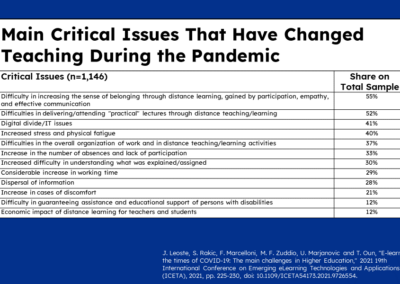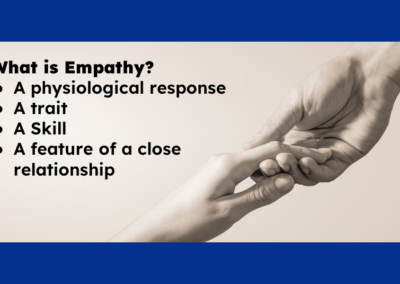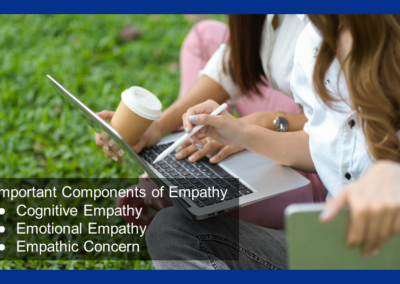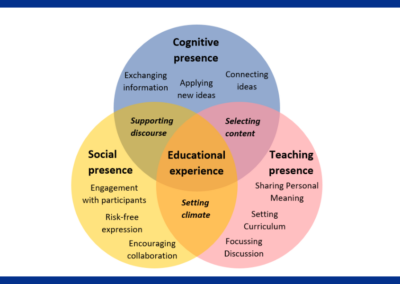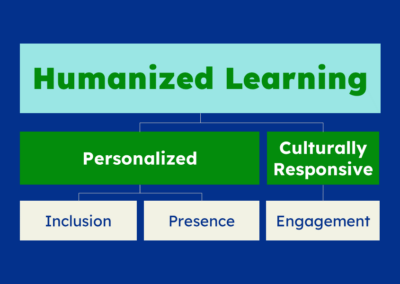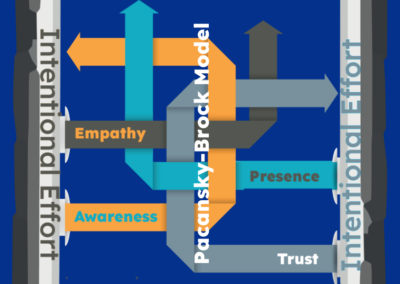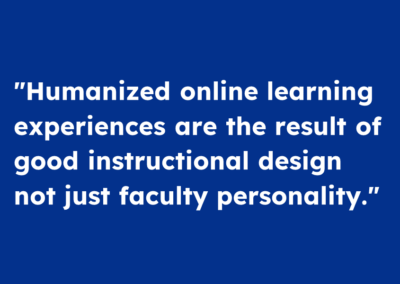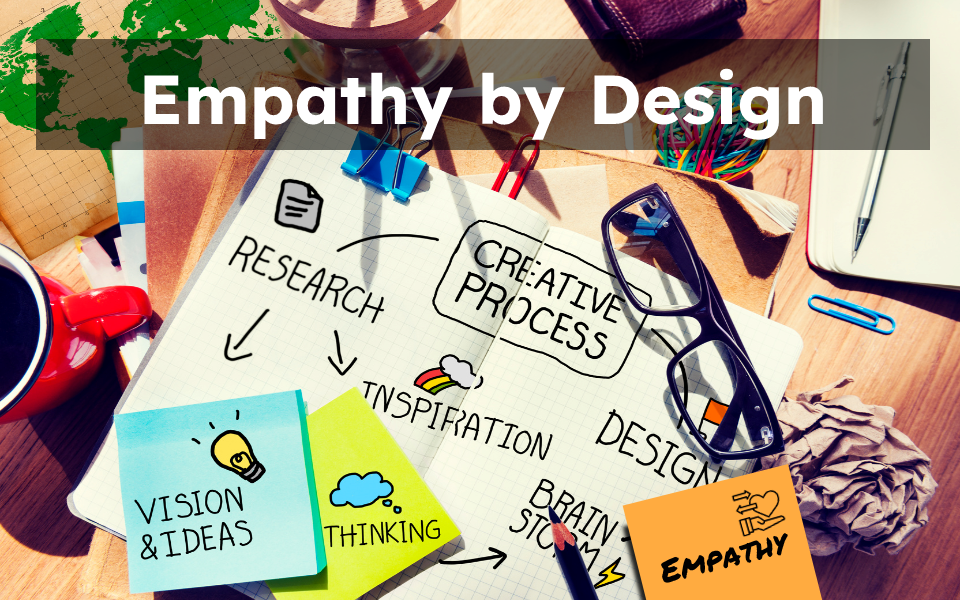
Empathy by Design
Being empathetic is essential for delivering a humanized course, but designing courses to facilitate emotional intimacy is challenging, and online students often perceive their instructors as distant and uncaring. In this session, we will define empathy, review research on its instructional impact, and make the case that online empathy is largely a matter of design, not personality.
Main Critical Issues That Have Changed Teaching During the Padnemic
Being empathetic is essential for delivering a humanized course, but designing courses to facilitate emotional intimacy is challenging, and online students often perceive their instructors as distant and uncaring. In this session, we will define empathy, review research on its instructional impact, and make the case that online empathy is largely a matter of design, not personality.
What is Empathy?
Is it a physiological response, a trait, a skill, or a feature of a close relationship? Empathy is the ability to emotionally understand what other people feel, see things from their point of view, and imagine yourself in their place. Essentially, it is putting yourself in someone else’s position and feeling what they are feeling. Empathy means that when you see another person suffering, such as after they’ve lost a loved one, you are able to instantly envision yourself going through that same experience and feel what they are going through. Dehumanization Many also fall victim to the trap of thinking that people who are different from them don’t feel and behave the same as they do. This is particularly common in cases when other people are physically distant. For example, when they watch reports of a disaster or conflict in a foreign land, people might be less likely to feel empathy if they think that those who are suffering are fundamentally different from themselves. Golden Rule Empathy vs. Sympathy vs. Compassion Mark 6:34 And Jesus, when he came out, saw much people, and was moved with compassion toward them, because they were as sheep not having a shepherd: and he began to teach them many things.
Important Components of Empathy
Cognitive Empathy, Emotional Empathy, and Empathic Concern. Cognitive empathy I understand why you might be feeling that way Cognitive empathy, also known as empathic accuracy, involves “having more complete and accurate knowledge about the contents of another person’s mind, including how the person feels,” Hodges and Myers say. Cognitive empathy is more like a skill: Humans learn to recognize and understand others’ emotional state as a way to process emotions and behavior. Cognitive empathy is the ability to understand how a person feels and what they might be thinking. Cognitive empathy makes us better communicators, because it helps us relay information in a way that best reaches the other person. Emotional empathy I feel that student’s empathy Emotional empathy (also known as affective empathy) is the ability to share the feelings of another person. Some have described it as “your pain in my heart.” This type of empathy helps you build emotional connections with others. How would we show emotions empathy? I might say “my heart hurts for you” Empathic concern- Act upon it I want to do something about it Compassionate empathy (also known as empathic concern) goes beyond simply understanding others and sharing their feelings: it actually moves us to take action, to help however we can.
Communities of Inquiry Infographic
The intersection of Social, Cognitive, and Teaching Presence is Educational experience. The community of inquiry (COI) model is based on the perspective that complex, deeper level learning occurs through a community of learners who participate in reflective thinking and discussion, especially in the online classroom (Garrison, Cleveland-Innes, & Fung, 2010). The importance of the COI model lies in its identification of three overlapping elements which are critical to a successful online learning experience: teaching presence, cognitive presence, and social presence (Garrison, Anderson, & Archer, 2010; Garrison & Arbaugh, 2007).
Humanized Learning
A critical approach to humanizing pedagogies in online teaching and learning+ The historical roots of humanizing pedagogies are often traced back to Paulo Freire’s work on pedagogies of the oppressed and related traditions of critical pedagogy (Bartolome, 1994; Freire and Ramos, 1970; Luke, 2018). Critical pedagogies must necessarily be recontextualized to meet the needs and aspirations of those they intend to serve, so instead, we offer the questions our students have helped us understand as a starting point for moving this work forward: For whom might the educational experiences we envision and enact be humanizing? Who might our practices inadvertently exclude? And how can we, as participants in the teaching-learning process, better address these differences? From whose perspective are particular practices considered “humanizing”? In what ways might these approaches lead to experiences of dehumanization, despite good intentions? In what ways do the conditions we subject our teachers to promote the ideals of humanizaçao? In what ways might we, as institutions, foster conditions that promote humanizing experiences for both teachers and students?
Pacansky-Brock Model
Pacansky-Brock Model Humanizing online teaching to equitize higher education Humanizing recognizes that engagement and achievement are social constructs developed through the background and experiences students bring to college and the educational environment provided for them. Looking at engagement and achievement through this lens nudges educators to shift the burden from students to the barriers within our practices. (Interesting – https://onlinenetworkofeducators.org/how-and-why-to-humanize-your-online-course/ ) The Principles Humanized online teaching is supported by four interwoven principles: Trust: As an instructor, it is your responsibility to intentionally cultivate student trust, and one way to do it is by practicing “selective vulnerability” (Hammond, 2014) in the online community you build with your learners. Choose to share aspects of your life that portray you as a real person – tell a story about a personal struggle you worked through or record a video while cooking dinner or walking your dog. – I share about my lung condition/ one year I did my intro video after work in my living room (just as I am) Presence involves intentional efforts to construct your authentic self through brief, imperfect videos to ensure your students know you are in this journey with them (Costa, 2020). Verbal and nonverbal cues add context to your communications, which is important to support culturally diverse students. Awareness is achieved by learning about who your students are and how you can support them. Empathy requires you to slow down, see things through your students’ eyes without judgment, be flexible, and support them towards their goals. An interwoven fabric of threads labeled trust, empathy, awareness, and presence. Trust runs up and down on each thread, while each of the other principles runs left to right only on one thread, symbolizing trust as the foundational element of humanizing.

